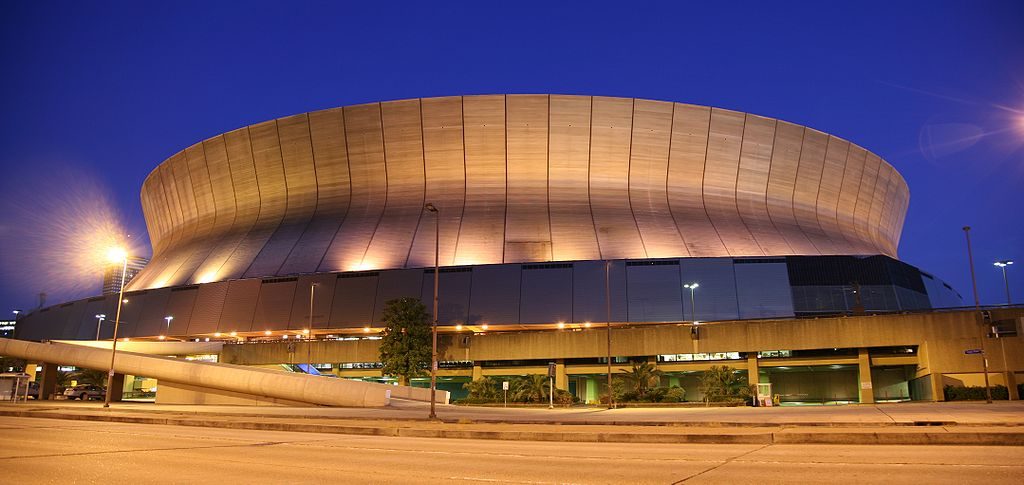As drone incursions at sporting events surge, stadium operators and law enforcement push for Congressional action on counter-UAS measures.
By DRONELIFE Features Editor Jim Magill
This is the fourth in a series of articles, examining the problems posed to critical infrastructure sites and other significant potential targets of drone incursions by hostile actors. Previous installments examined current federal laws pertaining to the use of counter-drone technology, and the threats from UAVs faced by jails and prisons and conventional and nuclear power plants.
This article will look at what steps can be taken to limit potential dangers from drones flying close to sports stadiums.
As eager fans prepare to make their way toward the Caesars Superdome in New Orleans for Super Bowl LIX this Sunday, chances are that more than a few of them will be keeping one eye toward the sky – scanning to see if any drones improperly invading the airspace near the stadium – might be prepared to interrupt their fun.


The FAA has declared the airspace within a radius of 3 nautical miles of the stadium as a ‘No Drone Zone’ on Super Bowl Sunday. Drones also are prohibited around the downtown area during the days leading up to the event. Drone operators who enter the restricted areas without permission could face confiscation of their drone, fines up to $75,000 and potential criminal prosecution.
The potential threat from UAVs — flown by operators that are careless, clueless or even criminal — over sports stadiums and their surrounding environments has grown exponentially in recent years. And stadium operators as well as state and local law enforcement agencies are severely constrained in the type of measures they can take to counter the threat.
Under FAA rules drone flights are prohibited in the airspace surrounding events staged by the National Football League, Major League Baseball, NCAA Division One Football and NASCAR Sprint Cup, Indy Car, and Champ Series races starting one hour before and ending one hour after the scheduled time of the event.
However, these restrictions do not deter every UAV pilot who may be ignorant of the rules, or deliberately ignoring them. In January 2025, counter-drone defense company Dedrone reported that there were 137 temporary flight restriction violations at events and venues in the U.S. Last year, the company recorded 12,624 venue TFR violations, up from 11,647 the previous year.
The NFL itself has had perhaps more than its share of drone-related incidents. Last month, a wild-card playoff game between the Baltimore Ravens and Pittsburgh Steelers was temporarily paused when a drone was sighted flying close to M&S Bank Stadium in Baltimore. Last February a man was charged Monday with illegally flying a drone over the same stadium during the 2024 AFC championship game.
Public information campaigns have been largely unsuccessful in curbing the number of drone-related incidents at sports venues. For example, in 2021, the FAA had launched a “Leave Your Drone at Home,” campaign, in cooperation with the Stadium Managers Association (SMA).
“The impetus for the program was and is to bring the public’s attention to the flight restrictions that are in place for most major stadiums during game or race days,” said SMA legal counsel Mike McCormick.
As part of the campaign, the FAA provided stadium operators with tool kits consisting of posters and other material encouraging sports fans to abide by the temporary flight restrictions pertaining to sporting events.
Congress called to step in with solution
In a recent statement, Cathy Lanier, NFL’s chief security officer, cited the number of drone-related incidents occurring at NFL games and called on Congress to pass legislation to help protect major sporting events against the risk of drone incursion.
“Over the past several years, an increasing number of drones have flown into restricted airspace during NFL games,” Lanier said.
She said that threats, incidents and incursions by unauthorized drones over NFL games jumped from a dozen in 2017 to more than 2,800 in 2023.
Last December, Lanier testified in writing before a congressional hearing on counter-UAS security measures, in favor of proposed legislation that would give state and local law enforcement agencies more authority to take mitigation measures against drones that pose a danger to the sports-going public.
The “stadium and sporting event flight restriction is well-established and geographically and temporally limited,” she wrote. “State and local law enforcement officials, however, still lack the authority to enforce the longstanding TFRs by taking action against rogue drones.”
Over the past several years, the NFL has joined with other sports organizations — including Major League Baseball, NASCAR and the NCAA – to lobby Congress for several years to pass legislation to give state, local, tribal and territorial law enforcement agencies the authority to counteract illegal drones over major sporting events and other potentially vulnerable sites.
In a statement, SMA’s McCormick agreed that the time is now for Congress to enact legislation to help protect sports venues from unwanted drone incursions.
“The SMA has been emphasizing the need to solve the counter-drone problem since 2016,” McCormick said. He cited a legislative proposed that would have permitted operators of critical infrastructure sites to restrict their own airspace within FAA and Department of Homeland Security guidelines.
“Unfortunately, despite explicit Congressional direction, that section has not been implemented. Likewise, it is paramount that local law enforcement be included in that solution as they will, in large part, be effectuating it,” he wrote.
“Bottom line, we believe that open-air stadiums, holding tens of thousands of fans and massive technologies, are a potential target for bad actors and negligent drone pilots.”
Want DRONELIFE news delivered to your inbox every weekday? Sign up here.
Read more:

 Jim Magill is a Houston-based writer with almost a quarter-century of experience covering technical and economic developments in the oil and gas industry. After retiring in December 2019 as a senior editor with S&P Global Platts, Jim began writing about emerging technologies, such as artificial intelligence, robots and drones, and the ways in which they’re contributing to our society. In addition to DroneLife, Jim is a contributor to Forbes.com and his work has appeared in the Houston Chronicle, U.S. News & World Report, and Unmanned Systems, a publication of the Association for Unmanned Vehicle Systems International.
Jim Magill is a Houston-based writer with almost a quarter-century of experience covering technical and economic developments in the oil and gas industry. After retiring in December 2019 as a senior editor with S&P Global Platts, Jim began writing about emerging technologies, such as artificial intelligence, robots and drones, and the ways in which they’re contributing to our society. In addition to DroneLife, Jim is a contributor to Forbes.com and his work has appeared in the Houston Chronicle, U.S. News & World Report, and Unmanned Systems, a publication of the Association for Unmanned Vehicle Systems International.


Miriam McNabb is the Editor-in-Chief of DRONELIFE and CEO of JobForDrones, a professional drone services marketplace, and a fascinated observer of the emerging drone industry and the regulatory environment for drones. Miriam has penned over 3,000 articles focused on the commercial drone space and is an international speaker and recognized figure in the industry. Miriam has a degree from the University of Chicago and over 20 years of experience in high tech sales and marketing for new technologies.
For drone industry consulting or writing, Email Miriam.
TWITTER:@spaldingbarker
Subscribe to DroneLife here.

